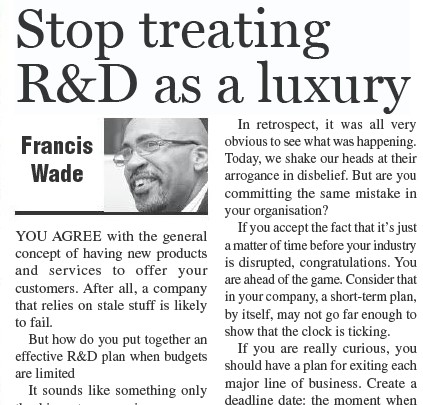You agree with the general concept of having new products and services to offer your customers. After all, a company that relies on stale stuff is likely to fail. But how do you put together an effective R&D plan when budgets are limited?
It sounds like something only the biggest companies overseas do. Most think that “Research and Development” are two luxury items to be indulged in when times are good. And Jamaica’s economy has not shown sustained GDP growth in years.
But what if R&D is just a fancy name for innovations you cannot afford to delay? Sadly, some only realise this in retrospect. Today, they are out of business because they failed to abandon old, obsolete thinking. How can your firm ensure that it doesn’t destroy value because it’s too slow to learn?
- Be Hyper-Curious About the End
Most of us remember when videotape rental companies did a booming business. To most, this appeared to be a great niche, with guaranteed traffic every weekend.
I happened to live in the US when Netflix arrived, offering the chance to rent a DVD by mail. Initially, it was inconvenient to send items through the post. Compared to renting a video from Blockbuster, it took longer and stuff could get lost.
Apparently Netflix agreed and tried to sell itself to Blockbuster…who literally laughed as they left in embarrassment.
A few years later, after they closed 9,000 stores, the smiles were replaced by tears.
In retrospect, it was all very obvious to see what was happening. Today, we shake our heads at their arrogance in disbelief. But are you committing the same mistake in your organisation?
If you accept the fact that it’s just a matter of time before your industry is disrupted, congratulations. You are ahead of the game. Consider that, in your company, a short-term plan, by itself, may not go far enough to show that the clock is ticking.
If you are really curious, you should have a plan for exiting each major line of business. Create a deadline date: the moment when you intend to earn your last dollar from the pertinent product or service.
Alongside this doomsday prediction should be a plan to launch a new category of product or service. Where should these timelines come from? Your long-term R&D plan, of course.
For example, immediately after making a record year of profits in 2000, Fuji Film’s research showed it had a 10-15-year end-game. Kodak also had fantastic sales, but was never curious enough about the future to take the right actions. Consequently, Fuji thrives in a whole different industry. Kodak is just a single tiny business, having destroyed an estimated US$9 billion of value.
- Allow Competing Alternatives in Your Planning
How should your company determine these choices?
In your next strategic planning session, ensure that you permit attendees to propose various visions of the future. (If team-members share the same age, gender and background, consider that to be an impediment.)
You want different points of view to emerge for your “Vision 2040”, for example. First, make sure you are all starting with the same facts. Then, invite advocates to describe their preferred future. Even if it makes others uncomfortable. Get them to share details as they paint a vivid picture and draw fellow participants in to expand it.
Do not squelch your colleagues.
When you have a number of candidate futures, stand back collectively and assess them, because it’s time to choose which one(s) to pursue.
In this moment of truth, you should be scared witless. Why? You could easily and unwittingly fall into the path of more videotapes. Or film.
In other words, you could doom your company. Or save it. Agonize if you will, but understand that your decision cannot easily be reversed. It’s just not the kind of choice that can be revisited whenever the breeze changes direction.
- Decide and kill off alternatives
Instead, treat this moment of selection as a final verdict which will assign time, money, manpower and other corporate resources. You are making a bet which has an unsure outcome, but understand that the team must be willing to stand by its selection.
However, this means that if major assumptions change, then it’s your duty to revisit the plan. But this should be rare.
Blackberry needed to do this when the iPhone turned out to be a serious threat, for example. Only a dose of humility would have saved it from obsolescence.
Unfortunately, this advice isn’t easy to take. Most shy away from the kind of hard conversations required until it’s too late.
Don’t disappoint your shareholders, employees, suppliers, pensioners, and other stakeholders by being slow or cowardly. Instead, make the difference by investing in your organisation’s future.
Francis Wade is the author of Perfect Time-Based Productivity, a keynote speaker and a management consultant. To search his prior columns on productivity, strategy, engagement and business processes, send email to columns@fwconsulting.com.

